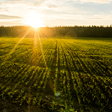- Home >
- Our Actions >
- Ambassador report
6
Comments
Urban Heat island (UHI) |
|---|
|
by Arushi Madan | 20-08-2017 02:41
|
|
What is the Urban Heat Island Effect? During the summer, especially during a heat wave like we have these days every year (in summer), the temperatures in cities like London, Birmingham, Manchester are considerably higher than those in surrounding rural areas. This is known as the 'Urban Heat Island' (UHI) Effect. This UHI phenomenon is a well-known effect of urbanisation and represents one of the most significant human-induced changes to Earth's surface climate. UHI effect is greatest in areas of densest building and tails off in the suburbs out to the countryside. UHI intensity varies across a city and over time, but temperature differences may reach 90C in the UK. Factors that contribute to a UHI include the thermal properties, height and spacing of buildings, the production of waste heat, air pollution, and differences in land cover and albedo. Even though they are localized hotspots in the landscape, UHIs have a profound impact on the lives of urban residents, who comprise more than half of the world's population. The UHI effect is important as heat-related stress accounts for around 1100 premature deaths per year in the UK – increasing noticeably in exceptionally hot years. An estimated 8 extra deaths occur each day for each degree increase in air temperature during UK summer heatwaves.
Heat Island Mitigation Strategies In UK, many communities are taking action to reduce urban heat islands using the following main strategies. One should consider adopting these to reduce the heat island effect.
Increasing shade around our home- Planting trees and other vegetation lowers surface and air temperatures by providing shade and cooling through evapotranspiration. Trees and vegetation that directly shade our home can decrease the need for air conditioning, making our home more comfortable and reducing our energy bill. Trees also protect our family's health by improving air quality, by providing cooling shade for outdoor activities, and reducing exposure to harmful UV radiation. Trees and vegetation can also reduce stormwater runoff and protect against erosion. Green Roofs - Growing a vegetative layer (plants, shrubs, grasses, and/or trees) on a rooftop reduces temperatures of the roof surface and the surrounding air and improves stormwater management. Also called 'rooftop gardens' or 'eco-roofs'/ green roofs achieve these benefits by providing shade and removing heat from the air through evapotranspiration. Cool Roofs - Installing a cool roof – one made of materials or coatings that significantly reflect sunlight and heat away from a building – reduces roof temperatures, increases the comfort of occupants, and lowers energy demand. Cool Pavements - Using paving materials on sidewalks, parking lots, and streets that remain cooler than conventional pavements (by reflecting more solar energy and enhancing water evaporation) not only cools the pavement surface and surrounding air, but can also reduce stormwater runoff and improve nighttime visibility. Smart Growth - These practices cover a range of development and conservation strategies that help protect the natural environment and at the same time make our communities more attractive, economically stronger, and more livable. Energy -efficient appliances and equipment- Using efficient appliances and equipment in our home can help to lighten the load on the electric grid during heat waves, thus ensuring a more reliable supply of electricity to the community. When purchasing products, we should look for EPA's ENERGY STAR label to help us make the most energy-efficient decision. Replacing our old appliances and equipment with ENERGY STAR-qualified products can also help save money. Direct heating by solar radiation can raise the temperature of a building's walls and roof to 60-650C. Depending on the building's construction material and insulation, this can result in elevated internal temperatures. Vegetation may be used as part of a building's fabric or landscape to reduce direct heating by solar radiation. Green roofs, as described above, for example, consist of a vegetated growing medium over a waterproof membrane. Bio-shade is a collective term for shade-casting pot plants and plant-draped pergolas. In both cases, they alter a building's microclimate by providing a surface for evaporative cooling and by limiting solar warming, thereby reducing internal temperatures. Wider benefits include supported biodiversity and improved air quality. They also provide storm water management, as rainfall interception and the use of permeable surfaces lead to reduced run-off to drains. Proactive Approach: Proper Planning and development-: Planners and developers can help to combat the UHI and increase urban resilience to the impacts of climate change by making the most of opportunities, afforded through redevelopments, to green the urban environment, with priority planting given to large canopy trees. Trees grown near buildings in order to mitigate the localised impact of the UHI are best placed to the west, southwest or south of buildings in the UK, with small-leafed species likely to offer the greatest impact. Greenspaces and wider green infrastructure should be a minimum of 0.5 ha in order to achieve cooling at significant distances beyond the site boundaries. The right tree in the right place Tree selection: The extent to which vegetation cools the urban climate depends on species selection and strategic placement. Trees can be very long-lived, so species selection should always consider the projected future climate as well as current climatic conditions. Tree location: Trees placed close enough to directly shade buildings (termed shade-effect trees) can lower summertime energy demand to cool the building's indoor climate. Size is important: smaller trees casting less summertime shade cool less (McPherson, 1993). However, effects are also tempered by building size, vegetation type, spacing and position relative to the building. As the occurrence and intensity of extreme heat events is set to increase under the changing climate predicted for the UK, there are significant implications for the thermal comfort and health of city dwellers across many parts of the UK. UHI abatement is of significance to those engaged in the development and delivery of climate change adaptation plans, including urban planners, policy makers and health professionals. Urban planning, building design and landscaping can all provide strategies for mitigating the UHI. Vegetation has a key role to play in contributing to the overall temperature regulation of cities. Informed selection and strategic placement of trees and green infrastructure can reduce the UHI and cool the air by between 20C and 80C, reducing heat-related stress and premature human deaths during high-temperature events. Sources/References: http://ramconroofing.blogspot.ae/2013/11/what-is-urban-heat-island-effect.html https://www.epa.gov/heat-islands/heat-island-cooling-strategies http://centres.exeter.ac.uk/cee/prometheus/uhi_paper_preprint.pdf https://data.london.gov.uk/dataset/london-s-urban-heat-island www.forestry.gov.uk
|
  .png)  
|
|
|










 Previous : Overview of Urban heats Island...
Previous : Overview of Urban heats Island...









6 Comments
Greetings arushi
I hope you are doing well
Well written
Thank you so much for this report
Keep writing
Green cheers
Regards
Asmita Gaire
Posted 01-06-2020 11:08
thanks buddy
Posted 02-02-2018 16:38
good information
Posted 02-02-2018 16:37
Good to read about such a detailed report on Urban Heat Island mate. The mitigation measures were quite elaborative and easy to read. Especially, we need to improve our way of tree plantation. All we are doing is plating trees, but the facts like tree species, tree ecology, interreaction of tree and environment, tree density, etc are bot considered in many places. So , in my view for effective tree plantation all this points should be considered.
Posted 22-08-2017 03:16
Hi Arushi! Thanks for sharing your report on UHI in your country.
Your report was really informative, and I especially liked the parts you wrote about the various measures. It seems important that we should take both proactive and reactive mesures together! Thanks for great report!
Posted 20-08-2017 22:35
Very well presented report. Thanks for sharing:)
Posted 20-08-2017 12:37